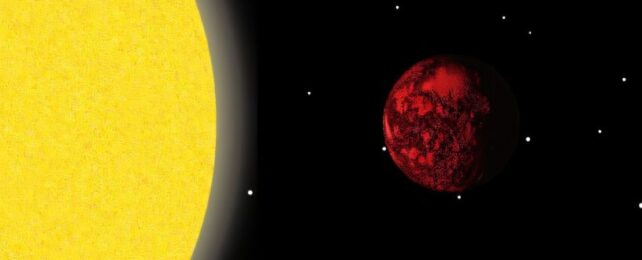Astronomers have discovered a hefty new Super-Earth that's as dense as lead. This rocky world might just be the leftover core of a gas giant that flew too close to its sun.
Meet K2-360 b, an exoplanet that packs 7.7 Earths-worth of mass into a ball that's just 1.6 times the size of our home world. That shakes out to a density of about 11 grams per cubic centimeter, on par with that of lead.
That makes it the densest known planet in its class – ultra-short-period (USP) Super-Earths. Granted, that's a very specific class, but even so, K2-360 b still ranks among the densest of all known exoplanets.
A planet's period is what we'd commonly call its year: how long it takes to orbit its host star. K2-360 b earns its "ultra short" moniker with a year that's shorter than an Earth day, just 21 hours.
Being cuddled up so close to the star not only helped astronomers find it, but it also provides some clues about how it came to be so dense in the first place.
K2-360 b was discovered in 2016, when the planet's shadow was spotted passing in front of its star by NASA's K2 mission. Follow-up observations have now allowed astronomers to measure its mass and radius, which they could then use to calculate its density.
This Super-Earth's lead-like density puts it in a very exclusive club. It's twice Earth's density of 5.5 grams per cubic centimeter, and still thicker than other high-density worlds like GJ 367b and TOI-1853b.
The absolute unit TOI-4603b has it beat, at a whopping 14.1 grams per cubic centimeter, but that one is right on the cusp of what can even be called an exoplanet – it might be better described as a brown dwarf or 'failed star.'
At the opposite end of the scale sit exoplanets in the Kepler 51 system, with densities of just 0.03 grams per cubic centimeter. For reference, that's roughly the density of cotton candy.
To figure out what makes K2-360 b so solid, the team created a model of the Super-Earth's interior, based on observations of it and its host star. From this, it seems that the planet probably has a big iron core that accounts for around 48 percent of its mass.
So how does such a cannonball of a planet even form? The researchers suggest that it may actually be the dead core of a world that was once much larger and resided farther away from the star. Over time it migrated inwards, where the intense radiation stripped away the gasses of its atmosphere, leaving a solid hunk of rock that's likely covered in oceans of lava.
Clues to this scenario were found in the wobble of the host star. It turns out that K2-360 b is not alone in the system – lurking farther out is a much larger planet, K2-360 c, with a size and density likely similar to that of Neptune.
"Our dynamical models indicate that K2-360 c could have pushed the inner planet into its current tight orbit through a process called high-eccentricity migration," says Niels Bohr Institute astrophysicist Alessandro Trani.
"This involves gravitational interactions that first make the inner planet's orbit very elliptical, before tidal forces gradually circularize it close to the star. Alternatively, tidal circularization could have been induced by the spin-axial tilt of the planet."
The study is just further proof that the Universe is lousy with strange planets that pulp sci-fi writers could only dream of.
The research was published in the journal Scientific Reports.
